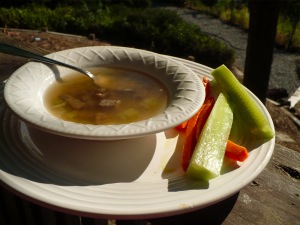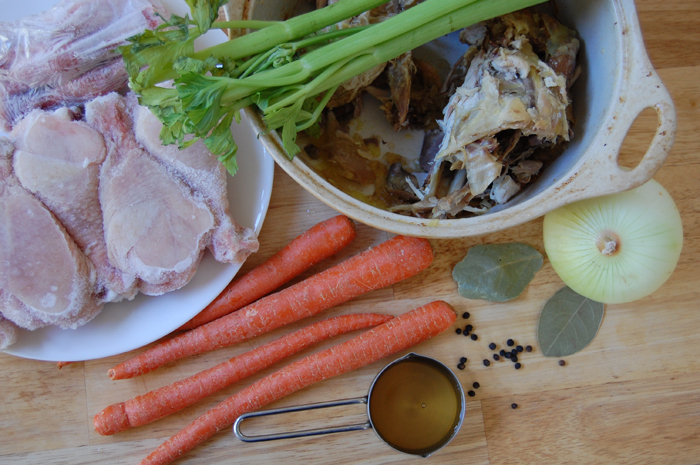I am pleased to introduce to you a great article on making frugal bone broths by Amanda Rose. I asked her to write this guest post because I thought that her thoughts on the topic would be helpful, and they certainly were! I love bone broths, from chicken broth to lamb broth. I also think they are an excellent source of calcium. Thanks Amanda for giving us more tips!
 Bone broth is a culinary and nutritional treat. Rich broth adds a depth of flavor to any of your soups and it will bring a great sense of fullness and satisfaction as it provides nourishment to your body.
Bone broth is a culinary and nutritional treat. Rich broth adds a depth of flavor to any of your soups and it will bring a great sense of fullness and satisfaction as it provides nourishment to your body.
Many of us are looking for healthier ways to feed our families and struggle increasingly with doing so on a budget. Bone broth has long been heralded as a budget-friendly mineral-rich ingredient. As budgets get tighter, it is time to reflect on bone broth and figure out how to get even more flavor and nutrition out of our bone broth dollars.
Earlier this year, my mother and I challenged ourselves to stretch our bone broth projects to their limit and discovered some incredible budget-friendly tidbits that will help you do the same.
Where to Buy Bones for Bone Broth
If you are on a tight budget, you will not be able to afford $5/pound (and more) organic beef bones at a health food store. Depending on the size of your crock pot or soup pot, you will likely want to fill it with two or three pounds of bones. Ten to fifteen bucks for a base ingredient is a bit high.
Many of us are looking for animal foods from animals raised on grass, but soup bones from grass fed animals start at about $5 per pound and go up from there. These bones will make an exquisite broth and I recommend them highly if you can afford them. However, if you cannot, I am here to reduce your guilt: The major health benefits of consuming grass-fed meats come in the fats, not in the bones. The bones of any animal will have a good amount of nutrition that you can integrate into your menu planning.
To find budget-friendly soup bones, look for a local ethnic market. In our area, Mexican and Asian markets have bones as stock items. Better still may be a local butcher if you are lucky enough to have one. In our area, local butcher shops process animals from family farms and small producers. These are not animals in large confinement systems. Our butcher actually sells “dog bones” because there is such a small market for soup bones. I can buy them for $1.50/pound and turn them into soup instead. You might check your phone book for butcher shops. Call and ask if they have “soup bones” or “dog bones.”
KH: I also wanted to note that in my area mostly grassfed soup bones are sold for around $1.50 per pound at my local store, and I can also get a whole box of grassfed beef bones (40 pounds) for $25 dollars through a private food co-op. So check out your local resources and see what you can find. You may be able to get better deals than you think!
Use Your Bones Again and Again (and Again)
Consider reusing your bones in batch after batch of broth until your bones disintegrate or until you simply get tired of the whole process and want to clean out your crock pot. Each batch of broth will have less flavor than the previous, but it will have nutrition nonetheless.
Earlier this year, we actually got twelve batches of gelatin broth from one batch of bones — soup bones high in gelatin called “beef feet.” (Gelatin is a component in bones that adds a richness to your broth and may even have healthful properties in its own right.) Every day for twelve days we poured off our broth and covered our bones again with water and a bit of vinegar and made another batch.
With our first three batches of broth, we made wonderful soups. As the broth lost flavor compared to the previous day, we would use the broth instead to cook beans or grains.
You can imagine that using this method you can have a continuous pot of broth going in your kitchen for an exceptional price.
For those wishing to test the limits of their soup bones, here are some recommendations from our kitchen:
- Plan to use your broth right away. Do not worry about storing it–just pour it right from your stock pot into a soup pot. It is hot and your soup is now halfway done. (With this approach you may want to roast beef bones in advance so that some of the fat is already removed and you may want to spoon off more fat as your broth simmers unless you want all of the fat in your soup.)
- After you pour off your broth, simply cover the bones again with water and add a bit of vinegar. You are onto the next round.
- Let each batch simmer for about 24 hours. We find that when you get into the 48-hour mark, beef broth can get a bit bitter. Chicken may get bitter sooner than that. KH: I find that after 24 hours, chicken broth can start becoming bitter.
- Consider adding vegetables to your broth for flavor, especially as your bones begin to lose flavor. If you do so, you will see that they get dark and may impart an “off” flavor to your broth if they are allowed to stay in your pot batch-after-batch. When we have vegetables in our crock, we tend to scoop them off the top and compost them before we pour off the broth. We may add a fresh onion to the new batch and scoop it off in the same way before the next batch. If you are pressed for time, it is easiest simply to let the bones simmer by themselves.
- Add a culinary vinegar to your broth. Vinegar does draw out minerals from the bones and will make each batch of broth that much more nutritious.
A Note on Chicken Broth
Our experience in testing the boundaries of broth-making was with beef bones, bones which have far more substance than chicken bones. Chicken bones will disintegrate long before twelve batches of broth, so do not be disappointed if this happens in your kitchen. I try to get about three batches of broth from a chicken carcass; my adventurous mother shoots for five. You can add chicken feet to your broth for a broth higher in gelatin, but you will not get anywhere near the gelatin you can get from beef feet. You can check at your local ethnic market for chicken feet for your chicken broth.
Your Bone Broth Experiments
In our experimentation, we have created a process that works for us in our kitchen and I share it here with you. (Find our bone broth resource for more.) The great thing about broth, however, is much like all cooking, the method that works best is the one that you can manage. If you tire of broth after three batches, by all means, you have had a good run and can stop. If you do not like to add vinegar to your broth, you will still have a great end-product without adding vinegar.
That said, I encourage you to begin your own bone broth experiments in your kitchen. Report back here to tell us what is working for you.
~~~
Find Amanda and her mother Jeanie at their free video course on broth and soup-making on Facebook. Learn how to get the most nutrition out of your bones and flavor out of your soup ingredients, all for the most frugal of prices — free.
Latest posts by KimiHarris (see all)
- 2 Ingredient Peppermint Bark - December 21, 2022
- Herbal Hibiscus Lemonade (Keto, THM) - March 16, 2022
- Creamy Curry Red Lentil Soup - December 8, 2021


I’ve been making stock for years now, only recently adding more meat to the process. At about the same time, I began to wonder about all the broths that were going down the sink—-I simmer a batch of chard; boil a measure of chick peas for hummus (what an incredible liquor); and I began to question the waste, simultaneous to the idea that all those celery ends, leafy stalks, and carrot parts, not to mention chard stems, and the clunky parts of mushrooms, that were being composted when it seemed that there were other uses for them—-what with all that stock…
I got one of those plastic Rubbermaid bins in which countless suburbanites love to store their Cheerios, and began to dump all my veg-ends, loose broths, and eventually, the fat I skimmed off my stock. Then I began to wonder—what about the bones? Those turkey bones are quite hefty, are they done after the first batch? No, actually, so I began to pull them out of the stock and toss them back into the bin.
I know enough to realize that I don’t exist in a vacuum, but it took a search on aspics to realize that there is a website for those of us who have a stock pot going fairly regulary, and I’m glad I found it.
Now all I need is an aspic recipe that doesn’t look like congealed chicken soup over cold chicken!
Can I re-use chicken feet for multiple batches of chicken broth?
I used the feet for 3 batches in a row in my instant pot pressure cooker, the first 2 times for drinking the bone broth and the 3rd time to use for making rice/quinoa. My broth consists of chicken feet, chicken backs, and goat marrow bones. Also added 1.5 tbsp ACV, 1 tea salt, a little carrot, celery, clove garlic, half onion. New veggies for the first 2 batches. I can’t believe how much better it is than the hippie expensive store bought stuff!
The first batch is solid gelatin at room temp, the second batch less gelatinous but still visible. The 3rd is more liquid but gelatinous in the fridge. Also, I was in a rush and didn’t blanch/peel/clip the nails off the feet, just made sure to strain well after cooking. I threw the bones into the instant pot strait from the freezer, I can’t believe how easy it was.
Do you pull the meat off and then return the bones for the second round? Or just leave everything intact?
Yes Laura, I get 2 boilings from a pot full of bones…save bones from 1st and 2nd boilings in freezer bags and freeze broth in different sized containers for future use.
Good post. Thank you.
I sometimes add one or two Star Anise seeds (NOT one or two whole anise flower heads!) to the stock pot to add a fuller sweetish flavor. Charlie – Canada
I respectfully disagree with the author. The main benefit of bone broth is NOT the fat, but the gelatin that comes from the bones. That’s the thing that helps build blood, helps treat anemia, etc..
I think the point was that the benefit of grassfed meat was in the fat – not that the benefit of bone stock was the fat.
Anyway, I have recently found an ethnic butcher that supplies 3 huge bags of chicken feet for just £5. I use one bag in a stock pot and make a wonderfully jellied stock over the course of 24 hours. Sometimes I add veg and aromatics, other times just vinegar. After 24 hours the bones are disintegrating and you know the stock is full of minerals.
I just scooped out a portion of jelly and heated in a pan with some leftover pork belly. Delicious breakfast soup and so nutritious.
great idea. how intellegently frugal. my 4 year old loves chicken broth and now we can make enough to last all week without going off our budget thank you.
This post has helped me so much I wanted to share my experiences. After roasting our Thanksgiving turkey, I place the carcass in the slow cooker with a tea pot of boiling water. I set the slow cooker on high for two hours, add more boiling water to just under capacity and then set to low for 24 hours. I strain the broth and either freeze the broth or make it into soup right away.
After allowing the bones to cool for a bit, I remove all remaining meat and break up some of the bones. I add a tablespoon of apple cider vinegar and repeat the slow cooker process once more. This second time with open bones seems to produce a different type of gelatinous broth. After this batch, I mash up the bones to a meal and feed small amounts to my dogs with some broth and meat. My dogs are Border Collie/Queensland Heeler mixes and seem to thrive on a more wild-type diet. I am not sure how other more heavily bred dogs would do, but my dogs’ energy levels and coats have improved immensely.
Hope this helps some of you!
I imagine a way to solve both the storage problem and the loss of flavor with successive batches is to cook them down on the stove. Less water = more flavor with less volume. The idea of cooking chicken bones more than once just occurred to me recently (duh), but I’m glad to find that this is indeed a “thing”. I buy my chickens local and free-range, and due to the price I haven’t had an endless supply of broth – until now! 🙂 In addition to adding it to soups, I use frozen chicken broth cubes stuffed in a Kong(R) to help my dog tolerate her physical therapy, and when we run out there aren’t many other options. Now I can get more out of expensive poultry and keep my dog on a more consistent PT schedule.
I’m pretty new to making chicken bone broth.. My first attempts were from free breast carcasses from local butcher which made tasty broth but didn’t gelatinise.. So researched some more and found best parts of chicken to make a good golden gelatinous broth were feet, used 2 x 500g of feet with 6 drumsticks meat fell of the bone, continued to cook just feet and drumstick bones and got a glorious golden gel. Then I found out chicken necks also high in collagen so made batch in slow cooker 24 hrs and best broth so far.. Tried the second cooking of these bones but added veg but didn’t gel and very dark with bitter taste so think for me that when bones are mashable then I’m not going to get much more gel from bones.. Will keep using feet, and so happy to read I don’t need to cut nails off phew! I will follow all the wonderful info on here, so helpful, thankyou. Also after 2 months of drinking my bone broth I have much less pain from my 65 Yr old cranky spine and the skin on my legs, which had become terribly dry crepey wrinkled has vastly improved yay best of all as I have inability to digest solid food due to chronic pancreatitis my gut has soothed and the terrible bloating of upper abdomen has gone! This stuff is magic, I now know I’m absorbing all the aminos minerals etc I was missing.